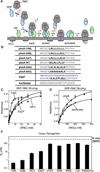Sequential checkpoints govern substrate selection during cotranslational protein targeting
- PMID: 20448185
- PMCID: PMC3760334
- DOI: 10.1126/science.1186743
Sequential checkpoints govern substrate selection during cotranslational protein targeting
Abstract
Proper protein localization is essential for all cells. However, the precise mechanism by which high fidelity is achieved is not well understood for any protein-targeting pathway. To address this fundamental question, we investigated the signal recognition particle (SRP) pathway in Escherichia coli, which delivers proteins to the bacterial inner membrane through recognition of signal sequences on cargo proteins. Fidelity was thought to arise from the inability of SRP to bind strongly to incorrect cargos. Using biophysical assays, we found that incorrect cargos were also rejected through a series of checkpoints during subsequent steps of targeting. Thus, high fidelity of substrate selection is achieved through the cumulative effect of multiple checkpoints; this principle may be generally applicable to other pathways involving selective signal recognition.
Figures




Similar articles
-
Predominant membrane localization is an essential feature of the bacterial signal recognition particle receptor.BMC Biol. 2009 Nov 13;7:76. doi: 10.1186/1741-7007-7-76. BMC Biol. 2009. PMID: 19912622 Free PMC article.
-
Regulation of cargo recognition, commitment, and unloading drives cotranslational protein targeting.J Cell Biol. 2014 Jun 9;205(5):693-706. doi: 10.1083/jcb.201311028. J Cell Biol. 2014. PMID: 24914238 Free PMC article.
-
Molecular Mimicry of SecA and Signal Recognition Particle Binding to the Bacterial Ribosome.mBio. 2019 Aug 13;10(4):e01317-19. doi: 10.1128/mBio.01317-19. mBio. 2019. PMID: 31409676 Free PMC article.
-
Fidelity of cotranslational protein targeting by the signal recognition particle.Annu Rev Biophys. 2014;43:381-408. doi: 10.1146/annurev-biophys-051013-022653. Annu Rev Biophys. 2014. PMID: 24895856 Free PMC article. Review.
-
Structural insights into the signal recognition particle.Annu Rev Biochem. 2004;73:539-57. doi: 10.1146/annurev.biochem.73.011303.074048. Annu Rev Biochem. 2004. PMID: 15189152 Review.
Cited by
-
ATPase and GTPase Tangos Drive Intracellular Protein Transport.Trends Biochem Sci. 2016 Dec;41(12):1050-1060. doi: 10.1016/j.tibs.2016.08.012. Epub 2016 Sep 19. Trends Biochem Sci. 2016. PMID: 27658684 Free PMC article. Review.
-
Activated GTPase movement on an RNA scaffold drives co-translational protein targeting.Nature. 2012 Dec 13;492(7428):271-5. doi: 10.1038/nature11726. Nature. 2012. PMID: 23235881 Free PMC article.
-
Staying on message: ensuring fidelity in pre-mRNA splicing.Trends Biochem Sci. 2012 Jul;37(7):263-73. doi: 10.1016/j.tibs.2012.04.001. Epub 2012 May 5. Trends Biochem Sci. 2012. PMID: 22564363 Free PMC article. Review.
-
Structures of the scanning and engaged states of the mammalian SRP-ribosome complex.Elife. 2015 Jul 9;4:e07975. doi: 10.7554/eLife.07975. Elife. 2015. PMID: 26158507 Free PMC article.
-
Protein translocation across the rough endoplasmic reticulum.Cold Spring Harb Perspect Biol. 2013 Feb 1;5(2):a013342. doi: 10.1101/cshperspect.a013342. Cold Spring Harb Perspect Biol. 2013. PMID: 23251026 Free PMC article. Review.
References
Publication types
MeSH terms
Substances
Grants and funding
LinkOut - more resources
Full Text Sources
Molecular Biology Databases

